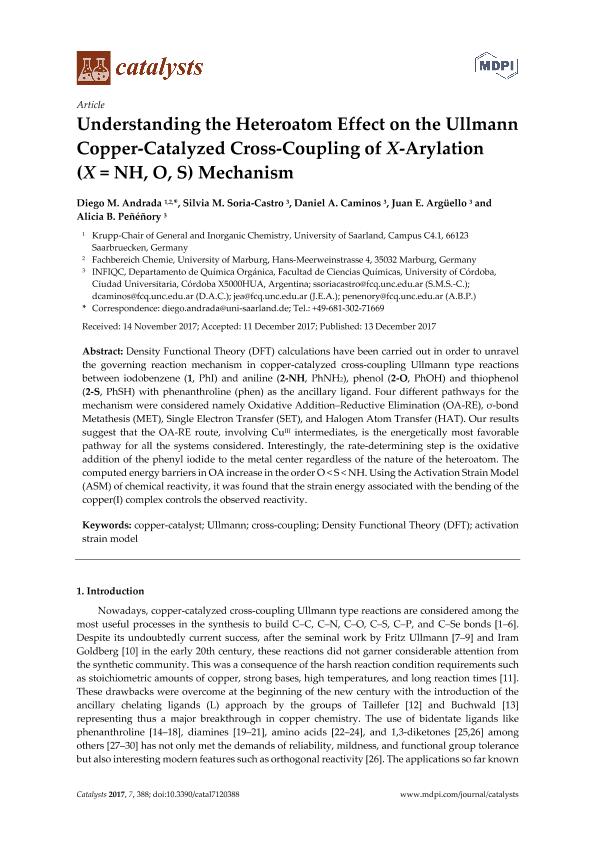Mostrar el registro sencillo del ítem
dc.contributor.author
Andrada, Diego Marcelo

dc.contributor.author
Soria Castro, Silvia Mercedes

dc.contributor.author
Caminos, Daniel Alberto

dc.contributor.author
Argüello, Juan Elias

dc.contributor.author
Peñeñory, Alicia Beatriz

dc.date.available
2018-04-24T21:10:14Z
dc.date.issued
2017-12
dc.identifier.citation
Andrada, Diego Marcelo; Soria Castro, Silvia Mercedes; Caminos, Daniel Alberto; Argüello, Juan Elias; Peñeñory, Alicia Beatriz; Understanding Heteroatom Effect on Ullmann Copper-Catalyzed Cross-Coupling of X-Arylation (X = NH, O, S) Mechanism; MDPI; Catalysts; 7; 12-2017; 388-405
dc.identifier.issn
2073-4344
dc.identifier.uri
http://hdl.handle.net/11336/43398
dc.description.abstract
Density Functional Theory (DFT) calculations have been carried out in order to unravel the governing reaction mechanism in copper-catalyzed cross-coupling Ullmann type reactions between iodobenzene (1, PhI) and aniline (2-NH, PhNH2), phenol (2-O, PhOH) and thiophenol (2-S, PhSH) with phenanthroline (phen) as the ancillary ligand. Four different pathways for the mechanism were considered namely Oxidative Addition?Reductive Elimination (OA-RE), σ-bond Metathesis (MET), Single Electron Transfer (SET), and Halogen Atom Transfer (HAT). Our results suggest that the OA-RE route, involving CuIII intermediates, is the energetically most favorable pathway for all the systems considered. Interestingly, the rate-determining step is the oxidative addition of the phenyl iodide to the metal center regardless of the nature of the heteroatom. The computed energy barriers in OA increase in the order O < S < NH. Using the Activation Strain Model (ASM) of chemical reactivity, it was found that the strain energy associated with the bending of the copper(I) complex controls the observed reactivity.
dc.format
application/pdf
dc.language.iso
eng
dc.publisher
MDPI
dc.rights
info:eu-repo/semantics/openAccess
dc.rights.uri
https://creativecommons.org/licenses/by-nc-sa/2.5/ar/
dc.subject
Copper-Catalyst
dc.subject
Density Functional Theory (Dft)
dc.subject
Activation Strain Model
dc.subject
Ullmann
dc.subject
Cross-Coupling
dc.subject.classification
Otras Ciencias Químicas

dc.subject.classification
Ciencias Químicas

dc.subject.classification
CIENCIAS NATURALES Y EXACTAS

dc.title
Understanding Heteroatom Effect on Ullmann Copper-Catalyzed Cross-Coupling of X-Arylation (X = NH, O, S) Mechanism
dc.type
info:eu-repo/semantics/article
dc.type
info:ar-repo/semantics/artículo
dc.type
info:eu-repo/semantics/publishedVersion
dc.date.updated
2018-04-24T19:33:04Z
dc.journal.volume
7
dc.journal.pagination
388-405
dc.journal.pais
Suiza

dc.journal.ciudad
Basilea
dc.description.fil
Fil: Andrada, Diego Marcelo. Universitat Saarland; Alemania. University of Marburg; Alemania. Consejo Nacional de Investigaciones Científicas y Técnicas; Argentina
dc.description.fil
Fil: Soria Castro, Silvia Mercedes. Consejo Nacional de Investigaciones Científicas y Técnicas. Centro Científico Tecnológico Conicet - Córdoba. Instituto de Investigaciones en Físico-química de Córdoba. Universidad Nacional de Córdoba. Facultad de Ciencias Químicas. Instituto de Investigaciones en Físico-química de Córdoba; Argentina
dc.description.fil
Fil: Caminos, Daniel Alberto. Consejo Nacional de Investigaciones Científicas y Técnicas. Centro Científico Tecnológico Conicet - Córdoba. Instituto de Investigaciones en Físico-química de Córdoba. Universidad Nacional de Córdoba. Facultad de Ciencias Químicas. Instituto de Investigaciones en Físico-química de Córdoba; Argentina
dc.description.fil
Fil: Argüello, Juan Elias. Consejo Nacional de Investigaciones Científicas y Técnicas. Centro Científico Tecnológico Conicet - Córdoba. Instituto de Investigaciones en Físico-química de Córdoba. Universidad Nacional de Córdoba. Facultad de Ciencias Químicas. Instituto de Investigaciones en Físico-química de Córdoba; Argentina
dc.description.fil
Fil: Peñeñory, Alicia Beatriz. Consejo Nacional de Investigaciones Científicas y Técnicas. Centro Científico Tecnológico Conicet - Córdoba. Instituto de Investigaciones en Físico-química de Córdoba. Universidad Nacional de Córdoba. Facultad de Ciencias Químicas. Instituto de Investigaciones en Físico-química de Córdoba; Argentina
dc.journal.title
Catalysts
dc.relation.alternativeid
info:eu-repo/semantics/altIdentifier/doi/http://dx.doi.org/10.3390/catal7120388
dc.relation.alternativeid
info:eu-repo/semantics/altIdentifier/url/http://www.mdpi.com/2073-4344/7/12/388
Archivos asociados
